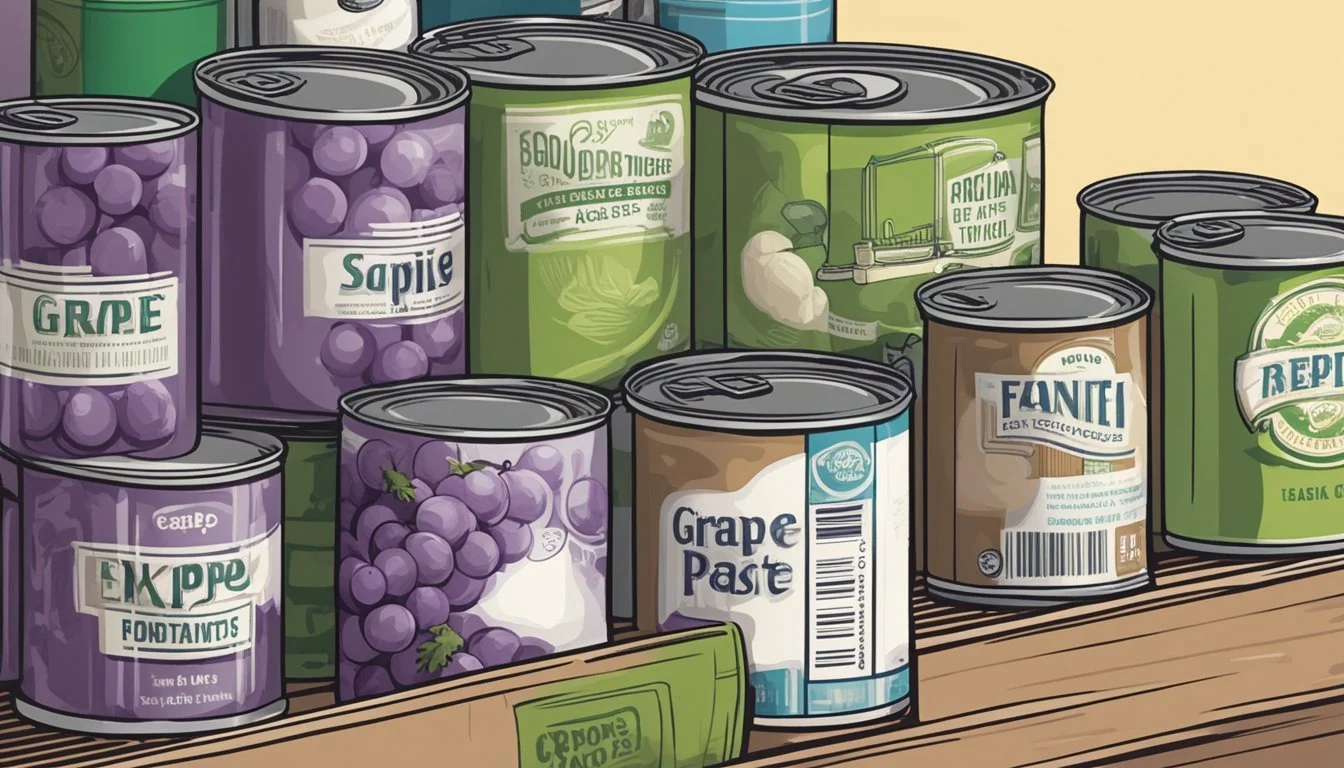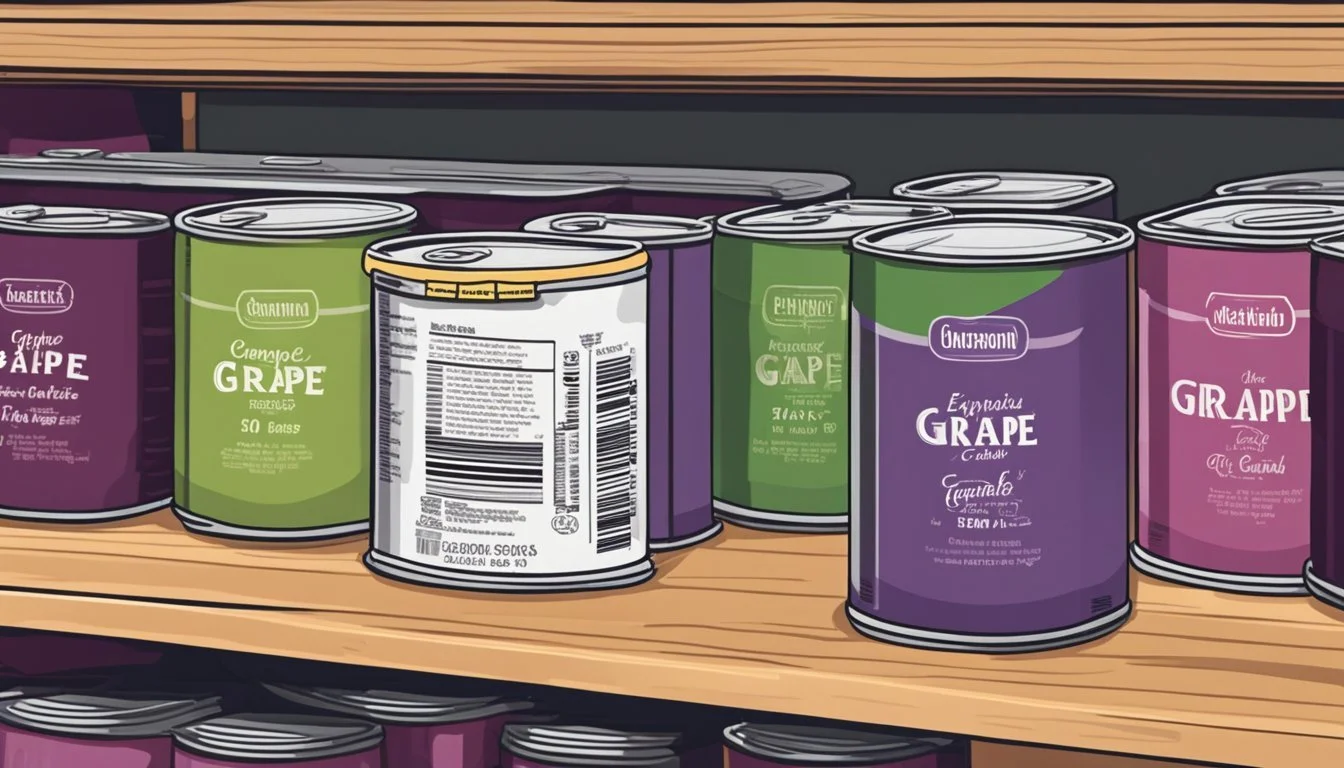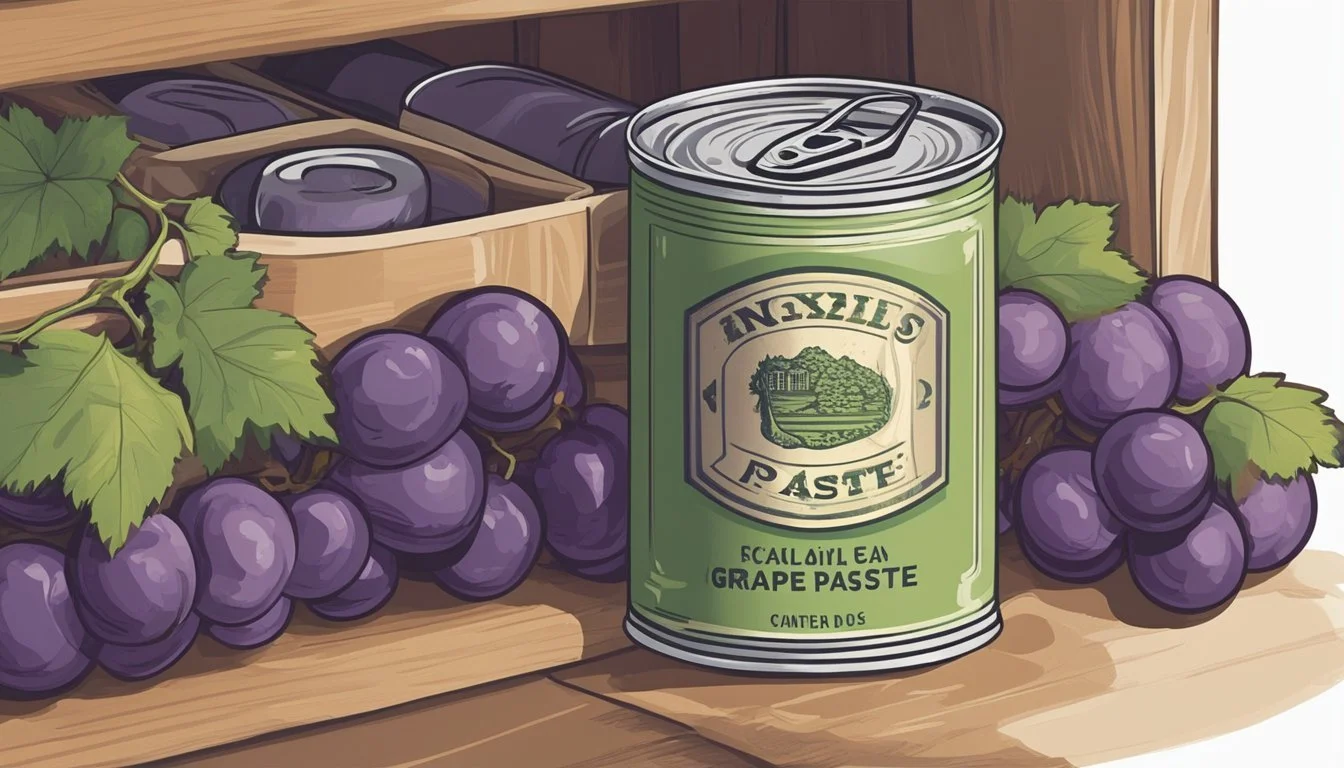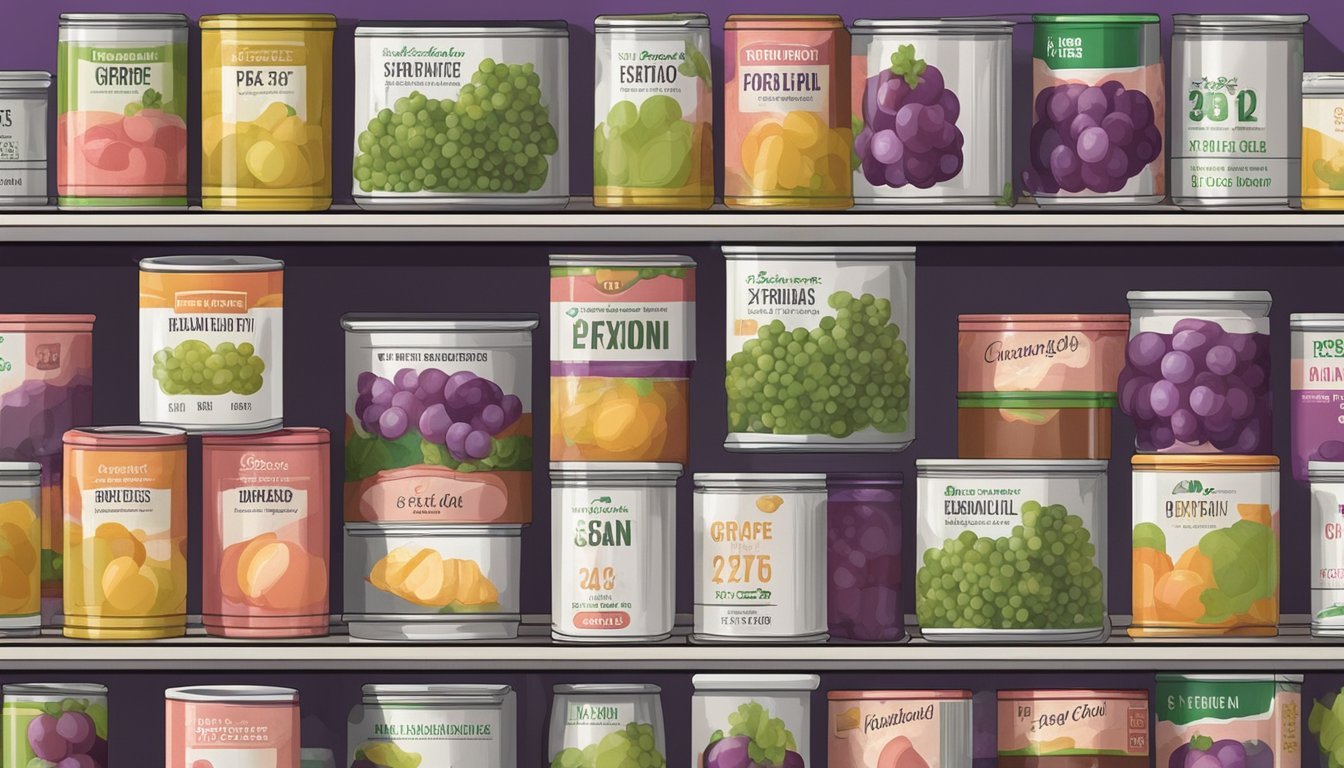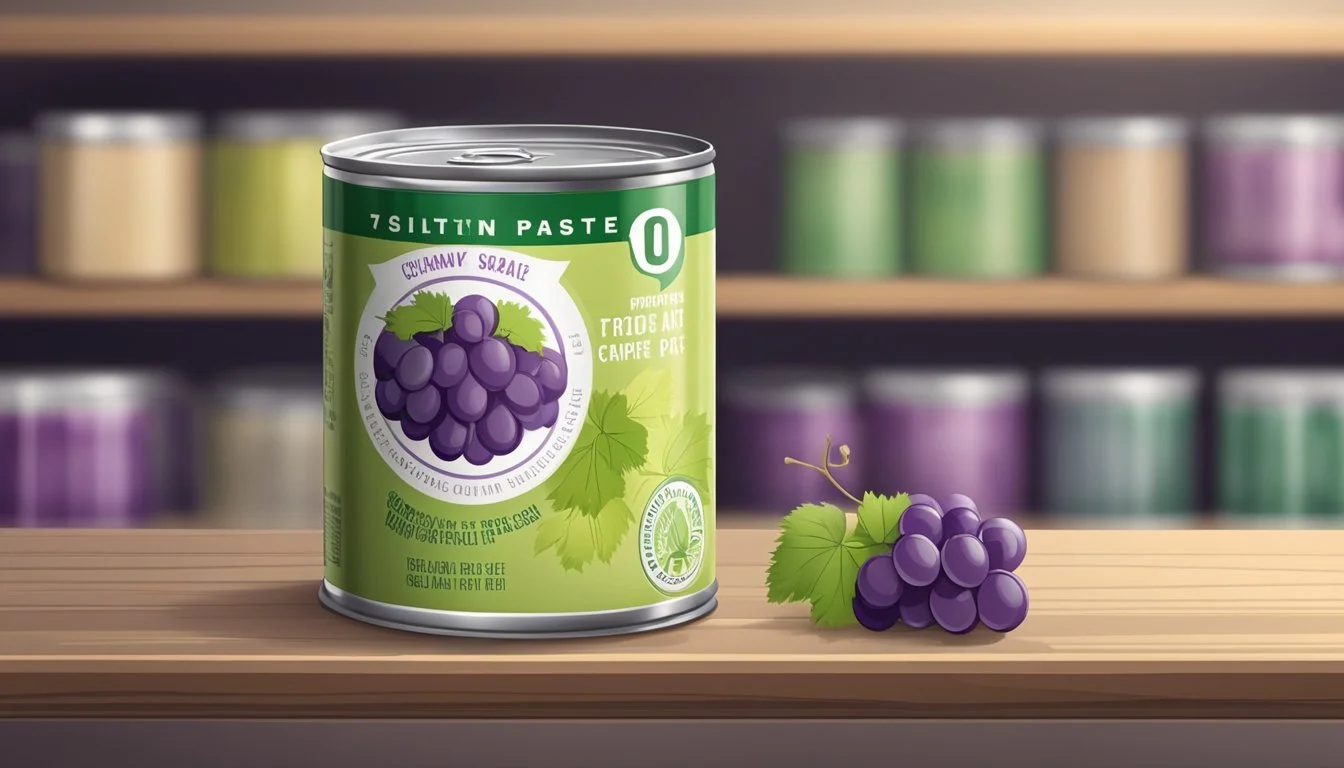How Long Does Canned Grape Past Last?
Shelf Life and Storage Tips
Canned products have long been valued for their extended shelf life and convenience, and canned grape paste is no exception. For those who enjoy the rich and concentrated flavor of grape paste as a spread, in baking, or as part of a cheese platter, understanding its longevity is important. Under optimal storage conditions, which include a cool, dark place, an unopened can of grape paste can typically maintain its quality for around 1 to 2 years past its printed expiration date.
The shelf life of canned grape paste is significantly influenced by factors such as the origin of the grapes, the canning process, and the integrity of the can's seal. While the expiration date gives a good indication of how long the grape paste will retain its taste, texture, and nutritional value, properly stored canned goods can often remain safe for consumption beyond this date. It is key to consider changes in flavor and quality, which may become noticeable over time, and decide if the paste is suitable for the intended use.
As with all canned foods, safety remains a top priority. A can that shows signs of damage, such as swelling, leakage, or rust, should be discarded, regardless of its expiration date. Regular inspection of cans in your pantry is a good habit to ensure the safety and quality of the contents before use. The safety of the product is not solely defined by the date printed on the can but also by its storage conditions and visible signs of spoilage.
Understanding Canned Grape Paste
Canned grape paste, as a preserved food product, provides convenience while retaining the flavor and nutritional qualities of the fruit it is derived from. The preservation process is instrumental in extending its shelf life and maintaining its unique properties.
Composition and Types
Canned grape paste typically consists of concentrated grape juice that is thickened and reduced until it reaches a paste-like consistency. The canning process involves sealing the paste in airtight containers, which can be either metal cans or glass jars. The types of grape paste can vary based on the grapes used, which influences the final taste and color of the product. Some grape pastes are made using a single grape variety, while others might blend different types to achieve a specific flavor profile.
Ingredients:
Grapes (type may vary)
Sugar (for sweetness and preservation)
Water
Nutritional Profile
The nutritional profile of canned grape paste is influenced primarily by its two main components: grapes and added sugar. The paste is a source of carbohydrates, primarily from natural sugars found in the fruit, and may contain minimal amounts of protein. It can be high in calories due to its concentrated form and added sugars, which should be considered when consumed as part of a balanced diet.
Nutritional Elements:
Calories: High, due to sugar concentration
Sugar: High, both natural and added
Protein: Minimal
The focus on the fruits used, quality control throughout the canning process, and the addition of sugars are important considerations that contribute to the canned grape paste's color, taste, texture, and overall flavor. As with other canned goods, maintaining the quality of the product ensures that it remains a desirable and enjoyable food item.
Factors Affecting Shelf Life
The shelf life of canned grape paste, like most canned goods, is influenced significantly by storage conditions and the methods used during the canning process. These factors are critical in determining how long the product will maintain its quality and safety for consumption.
Storage Conditions
Temperature and Light: Canned grape paste should be stored in a cool, dry place to maximize its shelf life. Temperatures should ideally be between 50° to 70°F (10 to 20°C). Exposure to high temperatures or direct sunlight can hasten the degradation of the product, potentially leading to spoilage before the expiration date.
Moisture and Air: It's vital to keep canned goods in an environment with low humidity to prevent rusting of the cans, which could compromise their airtight seals. Similarly, storing the paste in an airtight container once opened and in the refrigerator helps preserve its quality by minimizing exposure to air and moisture.
Canning Methods
Acidity Levels: Grape paste is typically considered a low-acid food, which requires careful canning to prevent the growth of bacteria such as botulinum. Home canning should always follow updated safety guidelines, including proper use of pressure canning methods to ensure food safety.
Preparation Techniques: Techniques like blanching, hot pack, and raw pack affect the longevity of the canned food. Blanching prior to canning can help inactivate enzymes that cause spoilage, whereas hot packing can reduce the amount of dissolved oxygen in the jar, which helps to preserve color and texture. Raw pack methods, while simpler, may result in a shorter shelf life compared to hot pack methods.
Identification of Spoilage
When assessing the spoilage of canned grape paste, one should be vigilant in identifying specific, detectable signs that indicate whether the product has gone bad, ensuring food safety and preventing health risks.
Visible Signs
Canned grape paste should be free from any visible mold, which can appear as fuzzy spots either inside the can or on the surface of the grape paste itself. The integrity of the can is paramount; signs of bulging, swelling, leaking, or severe dents may suggest bacterial growth, such as Clostridium botulinum, which can cause botulism. Additionally, rust on the can compromise the seal and the safety of the content.
Sensory Indicators
Individuals should trust their senses. An off odor, an unexpected change in color, or an alteration in texture can be strong indicators of spoilage. The grape paste should retain its original aroma and not emit any unpleasant smells. If there’s any doubt regarding the smell, the product should not be consumed. The taste is also a critical indicator; any sour or off flavors suggest that the grape paste should not be used, as these are clear signs that it has surpassed its shelf life.
Health Risks
Consuming spoiled canned foods poses serious health risks such as food poisoning. Symptoms can range from mild to severe and consuming foods contaminated with bacteria can cause illness or even be fatal. It is essential to examine canned grape paste for spoilage signs thoroughly as expiration dates are merely a guideline for optimal quality, and not always an exact indication of food safety. Checking for spoilage helps prevent the risk of consuming compromised foods and protects against the health risks associated with foodborne pathogens.
Preservation and Extension of Shelf Life
Maintaining the shelf life of canned grape paste is crucial for its quality during storage. Optimal conditions can significantly prevent spoilage and maintain the paste's properties.
Refrigeration Practices
Once opened, refrigerating canned grape paste is essential to preserve its quality. Under refrigeration, an opened can of grape paste should be transferred to an airtight container to prevent contamination and then stored at temperatures between 35°F to 38°F (1.7°C to 3.3°C). Refrigeration slows down the growth of microorganisms and is ideal for short-term storage of up to 7-10 days.
Freezing Canned Grape Paste
The process of freezing can extend the usable life of canned grape paste beyond refrigeration limits. When freezing, one should:
Ensure that the grape paste is placed in a freezer-safe container to prevent freezer burn.
Label the container with the current date for proper food storage management.
Maintain a constant freezing temperature of 0°F (-18°C) or below.
Frozen grape paste can be kept for up to 3 months for optimal quality. It's important to note that while freezing can extend shelf life, it may alter the texture of the grape paste once thawed.
Safe Consumption Guidelines
When considering the longevity of canned grape paste for safe consumption, it is essential to understand the meanings behind expiration labels and the proper care for opened containers.
Understanding Expiration Labels
The labels on canned goods such as grape paste typically indicate a sell-by date or an expiration date that informs consumers about the peak quality of the product, not necessarily its safety. The USDA states that high acidity foods will maintain their best quality up to 18 months, although they remain safe beyond this period if the can remains properly sealed. Canned grape paste, being a fruit product, falls under this category and therefore can be expected to be safe for consumption well past the marked date as long as the integrity of the can is uncompromised.
Label Type Meaning Sell-By Date Suggests when the product should be sold to ensure peak quality. Expiration Date Indicates the end of the period during which peak quality is expected.
Handling Opened Containers
Once a consumer opens a can of grape paste, the preservation benefit of canning is diminished, and the paste should be consumed within a shorter time frame to ensure food safety. An opened container of grape paste should be refrigerated and ideally used within 5 to 7 days. Even though the paste might still be safe to consume after this period, changes in taste, color, or texture can occur, signaling a decline in quality.
Refrigerate: Store in a covered glass or plastic container.
Observe: Look for any signs of spoilage before use, such as an off smell or discoloration.
Consume: Use within 5 to 7 days for optimal quality and safety.
It's important to abide by these guidelines to maintain food safety and ensure the best possible taste experience when consuming canned grape paste.
FAQs About Canned Grape Paste
How long does unopened canned grape paste last?
Unopened canned grape paste typically lasts for 1-2 years past the expiration date if stored in a cool, dry place. After this period, it may still be safe to consume but the quality may degrade.
Can I use canned grape paste after its expiration date?
Yes, one can often use canned grape paste after the expiration date if the can remains unopened, undamaged, and stored correctly. It should retain safety and quality for a few years, but always inspect the can and contents before use.
What is the ideal storage condition for canned grape paste?
Canned grape paste should be stored in a cool, dry environment, away from direct sunlight and significant temperature changes.
Does the same storage advice apply to canned grape leaves or grape juice?
Yes, canned grape leaves and grape juice should be stored under similar conditions. For canned grape leaves, one could expect a shelf life of about 3 to 5 years at best quality.
What should I look for to ensure the canned grape paste is still good to use?
One should look for signs of spoilage such as a swollen can, rust, leaking, an off odor, or a strange appearance of the grape paste itself.
How do I preserve the freshness of canned grape paste after opening?
Once opened, transfer the grape paste to an airtight container and refrigerate. Use within the recommended period, which is typically up to one month.
Is there a difference in shelf life between commercially canned grape paste and homemade?
Commercially canned products usually have a longer shelf life due to the canning processes used. Homemade canned goods should be enjoyed within one year for optimal freshness and quality.
Can grape jelly and grape jam last as long as canned grape paste?
Grape jelly and jam have similar shelf lives to canned grape paste when unopened. Once opened, they should also be refrigerated and used within one month for best quality.
Culinary Uses and Recipes
Canned grape paste is a versatile ingredient that can be used in a variety of culinary applications. Recipes often call for it as a sweet yet tart flavor component. The thick consistency of grape paste makes it ideal for spreading on toast or incorporating into dessert fillings.
One can find many canning recipes that utilize grape paste. Here are a few ways it can be used in the kitchen:
Grape Jelly: Simply spread it over your morning toast or biscuits for a quick breakfast.
Grape Jam: Combine it with other fruits for a complex jam blend.
Savory Sauces: Mix with vinegar and spices for a sweet and tangy meat glaze.
For food preservation enthusiasts, incorporating grape paste into canned grapes recipes offers a delightful twist. It adds depth and character to the preserved grapes, which can later be used in salads or as part of a cheese board.
Example Recipe: Grape Paste Glaze for Meat
Ingredients:
2 tbsp canned grape paste
1 tbsp balsamic vinegar
1 tsp chopped rosemary
Salt and pepper to taste
Instructions:
In a small bowl, mix the grape paste and balsamic vinegar until well combined.
Stir in the chopped rosemary.
Season with salt and pepper.
Brush over your choice of meat during the last minutes of cooking.
This glaze complements particularly well with pork and poultry, enhancing the dishes with a sweet and herby profile.
Conclusion
When considering the longevity of canned grape paste, it is imperative to look at it in the context of general canned goods and their shelf life. Canned grape paste, much like other low-acid canned foods—such as meats, vegetables, beans, and soups—typically maintains its quality for a considerable period.
Fresh fruit, like green grapes, are preserved to extend their shelf life, with grape paste being a versatile derivative known for its concentrated flavor.
Honey and sauerkraut are examples of naturally preservable foods due to their unique properties, but most canned goods, including grape paste, rely on the canning process.
Unopened canned grape paste usually remains safe to consume beyond the expiration date provided by the manufacturer if stored properly. In terms of quality:
Storage Time Quality Within 1 year Best quality 1-2 years past expiration Quality may decline, but still safe Over 2 years Quality decreases significantly
It is recommended to enjoy the grape paste while it's within the peak window for optimum flavor and texture. Tomato products, which are higher in acidity, may have a different shelf life compared to grape paste—a low-acid product.
Consumers are urged to inspect the can for signs of spoilage such as rust, dents, or bulging before use, irrespective of the printed expiration date. Proper storage, which means keeping the cans in a cool, dry place away from sudden temperature changes, plays a crucial role in preserving the paste's quality. Canned goods are a practical, safe food source, and with attention to storage practices, grape paste remains a valuable, long-lasting pantry item.

